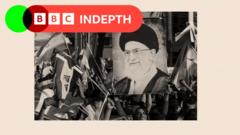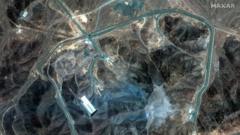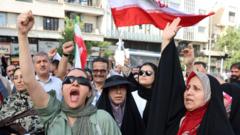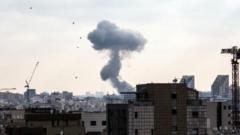This article explores the intricacies of 'Operation Midnight Hammer,' detailing the US strategy, execution, and the aftermath of air strikes on Iran's nuclear facilities, as revealed by Pentagon officials.
Inside 'Operation Midnight Hammer': A Detailed Look at the US Strikes on Iran’s Nuclear Facilities

Inside 'Operation Midnight Hammer': A Detailed Look at the US Strikes on Iran’s Nuclear Facilities
A comprehensive analysis of the recent US military operation targeting Iran’s nuclear sites, featuring insights from military leaders and the tactics employed.
In a highly secretive operation dubbed "Operation Midnight Hammer," the United States successfully executed airstrikes against Iran's nuclear facilities, revealing a complex narrative of military strategy and deception. The mission, which lasted 18 hours round trip, involved mid-air refuelings and a fleet of B-2 stealth bombers, as per the account provided by General Dan Caine, Chairman of the Joint Chiefs of Staff.
The strikes, initiated shortly after midnight under the watchful eyes of top US officials including President Donald Trump and Secretary of Defense Pete Hegseth, saw bombers depart from Whiteman Air Force Base in Missouri. Their objective was to target Iran’s fortified nuclear sites, particularly the critically significant Fordo facility, which lies deep underground and is known for its nuclear enrichment activities.
Distraction played a key role in the operation. As the B-2 bombers flew eastward over the Atlantic, the Pentagon crafted a narrative suggesting that US aircraft were deployed to the Pacific, thus diverting attention. “It was a decoy,” General Caine stated. The actual main strike force comprised seven B-2 bombers that executed their plan with minimal communication, enhancing the element of surprise.
As the bombers approached the Middle East, they were met with additional aircraft providing strategic support. Reports indicated that Iranian air defenses were largely inactive during the attack, potentially due to earlier Israeli operations that had asserted control over the airspace. This situation allowed the US bombers to carry out their missions unencumbered.
The series of coordinated strikes occurred around 18:40 EDT, employing Massive Ordnance Penetrator (MOP) bombs aimed at the Fordo site, marking a historical moment as these advanced weapons were used in real combat for the first time. The Pentagon reported that a total of 14 MOPs were utilized across various sites, including Natanz, while over 200 Tomahawk missiles were launched at Isfahan.
Despite declarations of success from US officials, including claims of significant damage inflicted on Iran's nuclear program, the full extent of the destruction remains closely watched. The Iranian government has acknowledged the strikes but has downplayed their impact, leaving analysts and military experts to assess the long-term implications.
Dr. Stacie Pettyjohn from the Center for a New American Security emphasized the sophistication of the operation, affirming that its tactical achievements might not necessarily translate into a lasting setback for Iran's nuclear ambitions. The unfolding geopolitical context, along with further evaluations, will ultimately determine the ramifications of 'Operation Midnight Hammer' on international relations and nuclear proliferation efforts in the region.





















